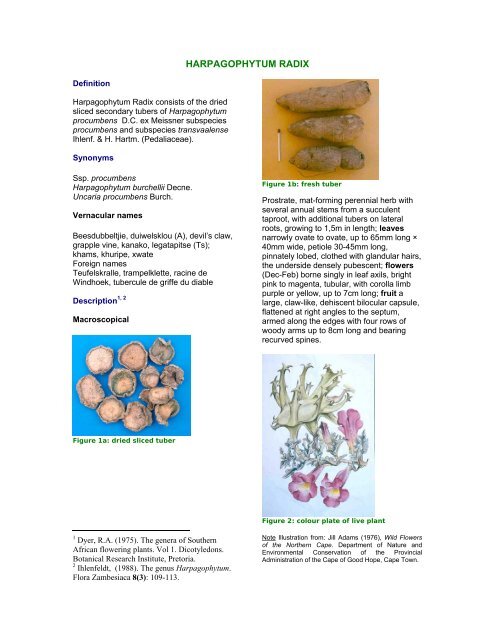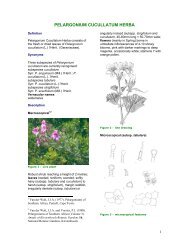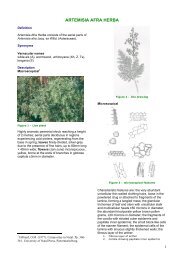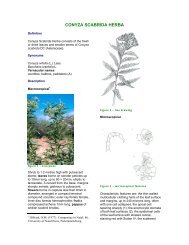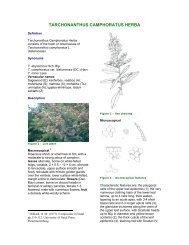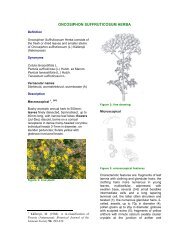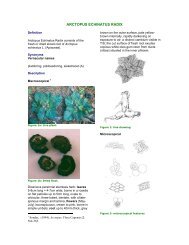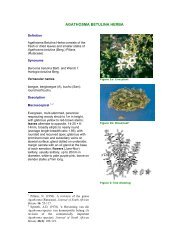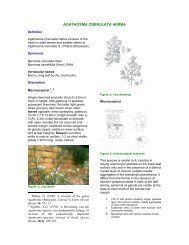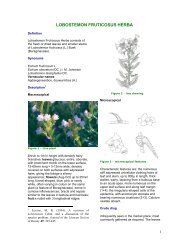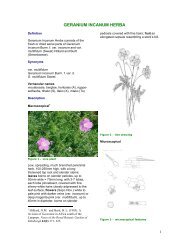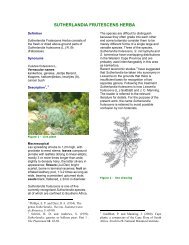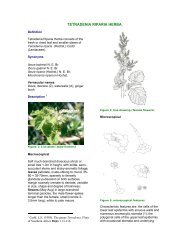HARPAGOPHYTUM RADIX - PlantZAfrica
HARPAGOPHYTUM RADIX - PlantZAfrica
HARPAGOPHYTUM RADIX - PlantZAfrica
You also want an ePaper? Increase the reach of your titles
YUMPU automatically turns print PDFs into web optimized ePapers that Google loves.
Definition<br />
Harpagophytum Radix consists of the dried<br />
sliced secondary tubers of Harpagophytum<br />
procumbens D.C. ex Meissner subspecies<br />
procumbens and subspecies transvaalense<br />
Ihlenf. & H. Hartm. (Pedaliaceae).<br />
Synonyms<br />
Ssp. procumbens<br />
Harpagophytum burchellii Decne.<br />
Uncaria procumbens Burch.<br />
Vernacular names<br />
Beesdubbeltjie, duiwelsklou (A), devil’s claw,<br />
grapple vine, kanako, legatapitse (Ts);<br />
khams, khuripe, xwate<br />
Foreign names<br />
Teufelskralle, trampelklette, racine de<br />
Windhoek, tubercule de griffe du diable<br />
1, 2<br />
Description<br />
Macroscopical<br />
Figure 1a: dried sliced tuber<br />
1 Dyer, R.A. (1975). The genera of Southern<br />
African flowering plants. Vol 1. Dicotyledons.<br />
Botanical Research Institute, Pretoria.<br />
2 Ihlenfeldt, (1988). The genus Harpagophytum.<br />
Flora Zambesiaca 8(3): 109-113.<br />
<strong>HARPAGOPHYTUM</strong> <strong>RADIX</strong><br />
Figure 1b: fresh tuber<br />
Prostrate, mat-forming perennial herb with<br />
several annual stems from a succulent<br />
taproot, with additional tubers on lateral<br />
roots, growing to 1,5m in length; leaves<br />
narrowly ovate to ovate, up to 65mm long ×<br />
40mm wide, petiole 30-45mm long,<br />
pinnately lobed, clothed with glandular hairs,<br />
the underside densely pubescent; flowers<br />
(Dec-Feb) borne singly in leaf axils, bright<br />
pink to magenta, tubular, with corolla limb<br />
purple or yellow, up to 7cm long; fruit a<br />
large, claw-like, dehiscent bilocular capsule,<br />
flattened at right angles to the septum,<br />
armed along the edges with four rows of<br />
woody arms up to 8cm long and bearing<br />
recurved spines.<br />
Figure 2: colour plate of live plant<br />
Note Illustration from: Jill Adams (1976), Wild Flowers<br />
of the Northern Cape. Department of Nature and<br />
Environmental Conservation of the Provincial<br />
Administration of the Cape of Good Hope, Cape Town.
Microscopical<br />
Figure 3: microscopical features<br />
Characteristic features are: the very large<br />
vessels up to 160µ in diameter with lignified<br />
pitted walls (3); the occasional sieve tubes<br />
and companion cells, staining light pink with<br />
phloroglucinol/HCl (6); the pale yellowbrown<br />
cork tissue (1); a matrix of thin-walled<br />
parenchyma with no intercellular spaces; the<br />
absence of starch, calcium oxalate crystals<br />
and fibres.<br />
Crude drug<br />
When fresh the tubers are light brown-buff in<br />
colour, with a slightly wrinkled appearance,<br />
up to 20cm long × 6cm in diameter; the<br />
freshly cut surface is pale cream, darkening<br />
rapidly on exposure to air and showing a<br />
distinct cambial ring. When sliced and dried,<br />
the crude drug consists of discs up to 5mm<br />
thick and 4cm in diameter; these are light<br />
brown, often with a greenish tinge and<br />
somewhat shrivelled; a dark cambial zone<br />
and radial rows of xylem are visible. Odour<br />
faint, taste very bitter, fracture short.<br />
Geographical distribution<br />
Quite widespread on deep sand in open<br />
savannah of arid regions in South Africa: the<br />
Northern and North-West Provinces,<br />
Northern Cape Province and the western<br />
Free State Province; also in Namibia,<br />
Botswana and Zimbabwe.<br />
Almost all the material used in commerce is<br />
obtained from natural stands in these<br />
countries and large quantities of tubers are<br />
exported annually. Despite concerns as to<br />
its conservation status, little cultivation of<br />
this species is currently undertaken.<br />
Figure 4: distribution map<br />
Quality standards<br />
Identity tests<br />
Thin layer chromatography on silica gel<br />
using as solvent a mixture of toluene:diethyl<br />
ether:1.75M acetic acid (1:1:1). Reference<br />
compound cineole (0,1% in chloroform).<br />
Method according to Appendix 2a.<br />
Rf values of major compounds: 0,12<br />
(purple); 0,33 (black); 0,42 (blue); 0,47<br />
(blue-green); 0,64 (blue-green); rutin<br />
marker; 0,35 (orange)<br />
Plate viewed in UV light (wavelength<br />
366nm)<br />
Figure 5: TLC plate<br />
HPLC on C18 column, method according to<br />
Appendix 2b.<br />
Major compounds:<br />
Methanol extract: Retention times (mins):<br />
8.42
Figure 6: HPLC spectrum<br />
Ethanol (70%) soluble extractive value: not<br />
less than 32% (range: 32.5 – 36.7%)<br />
See current editions of European<br />
Pharmacopoeia (EP) and British Herbal<br />
Pharmacopoeia (BHP):<br />
Total ash: not > 22% (BHP 1996); not > 8%<br />
(EP 1997)<br />
Water soluble extractive (BHP 1996): not <<br />
50%<br />
Acid-insoluble ash (BHP 1996): not > 5%<br />
Loss on drying (EP 1997): not > 0.5%,<br />
determined using 0.5g by drying in an oven<br />
at 100-105ºC.<br />
Purity tests<br />
Assay<br />
Harpagoside content (EP 1998): not < 1.2%<br />
(HPLC on reverse phase ODS column)<br />
Other published assay methods (BHP<br />
1996):<br />
Total iridoid glycosides (UV<br />
spectrophotometry)<br />
Harpagoside/harpagide content (GLC)<br />
Major chemical constituents 3<br />
1. Iridoid glycosides 0.5-3.0%,<br />
principally harpagoside (cinnamyl<br />
ester of harpagide), harpagide and<br />
procumbide. Secondary tubers<br />
contain twice as much harpagoside<br />
as do primary tubers 4 .<br />
2. Sugars: about 51%, principally the<br />
tetrasaccharide stachyose (up to<br />
46%) together with smaller amounts<br />
3 British Herbal Medicines Association (1992).<br />
British Herbal Compendium Vol. 1. Ed. Bradley,<br />
P.R. , BHMA, Dorset.<br />
4 Czygan, F-C. and Krüger, A. (1977).<br />
Pharmazeutisch-biologische untersuchungen der<br />
gattung Harpagophytum. 3. Planta Medica 31:<br />
305-307.<br />
of the trisaccharide raffinose,<br />
sucrose and monosaccharides.<br />
These sugars replace starch or<br />
other high MM polysaccharides as<br />
reserve carbohydrates and account<br />
for the high water soluble extractive<br />
fraction (50-70%)<br />
3. Triterpenoids: oleanolic acid, 3βacetyl<br />
oleanolic acid, ursolic acid<br />
4. Phytosterols: mainly β-sitosterol,<br />
stigmasterol and their glucosides<br />
5. Aromatic acids: caffeic, cinnamic,<br />
chlorogenic acids<br />
6. Flavonoids: luteolin, kaempferol<br />
Figure 7: chemical constituents<br />
Dosage forms<br />
Traditional:<br />
Aqueous infusions or decoctions are taken<br />
orally; an ointment prepared from fresh tuber<br />
is applied externally.<br />
Patent medicines:<br />
Tablets, tea, tincture, liquid extract, ointment<br />
Medicinal uses<br />
Traditional<br />
A decoction of the rootstock is taken by the<br />
Topnaar people of Namibia and many ethnic<br />
groups in South Africa to treat stomach or<br />
post-natal pains, fever, lack of appetite,<br />
indigestion and diabetes. An ointment is<br />
applied to ulcers, boils and external<br />
cancerous growths. 5, GR1 In Botswana, a<br />
decoction is taken to cure infectious<br />
5 Van den Eynden, V., Vernemmen, P. and van<br />
Damme, P. (1992). The ethnobotany of the<br />
Topnaar. University of Ghent/EU.
diseases, to treat female infertility and for<br />
pains in the limbs. 6<br />
Non-traditional GR 7, 8, 10, 17 (See also<br />
ESCOP 1996; German Commission E<br />
monograph)<br />
Preparations of the tuber are taken to treat<br />
painful arthroses, tendonitis, gout, lumbago,<br />
myalgia, dyspepsia and poor appetite and<br />
as supportive therapy for degenerative<br />
rheumatism.<br />
Pharmacology/bioactivity<br />
GR14, 17<br />
Devil’s Claw first came under scientific<br />
scrutiny during the 1950s when German<br />
scientists began investigating Namibian<br />
traditional medicines. Many in vitro, animal<br />
and clinical studies of its antiinflammatory/analgesic<br />
activity have since<br />
been conducted, mainly in Germany, using<br />
the crude drug or extracts of various kinds.<br />
The following reports are not intended to be<br />
a comprehensive review, for which the<br />
reader should consult the scientific literature.<br />
In vitro, animal and clinical studies of antiinflammatory/analgesic<br />
activity have been<br />
conducted using the crude drug or extracts<br />
of various kinds.<br />
In vitro studies have shown that a<br />
standardised 60% ethanolic extract<br />
containing 2.9% of harpagoside inhibited the<br />
release of tumour necrosis factor-alpha<br />
(TNF) induced by the treatment of human<br />
monocytes with lipopolysaccharide (LPS).<br />
Isolated harpagoside and harpagide were<br />
however ineffective in this assay.<br />
Harpagoside in the concentration range of<br />
10-100 µM has been shown to reduce<br />
thromboxane B2 synthesis in cells treated<br />
with calcium ionophore A23187 7 .<br />
6 Hedberg, I. and Staugard, F. (1989). Traditional<br />
medicine in Botswana. Ipeleng Publishers,<br />
Gaborone.<br />
7 Tippler, B., Syrovets, T., Loew, D. et al.<br />
(1996). Harpagophytum procumbens: wirkung<br />
von extrakten auf die eicosanoidbiosynthese in<br />
Ionophor A23187-stimuliertem menschlichem<br />
Vollblut. Pp. 95-100 In: Loew, D. and Rietbrock,<br />
N. (eds.) Phytopharmaka II: forschung und<br />
klinische Anwendung. Steinkopff, Darmstadt.<br />
The anti-inflammatory and analgesic effects<br />
of a dried aqueous extract of<br />
Harpagophytum procumbens and of<br />
harpagoside have been evaluated in rats<br />
and mice 8 . The extract was found to exert<br />
significant and dose-dependent antiinflammatory<br />
and analgesic effects in the<br />
carragenan-induced oedema and writhing<br />
tests respectively. Isolated harpagoside,<br />
assessed in the same two assays, did not<br />
appear to be involved in the antiinflammatory<br />
activity, but did contribute to<br />
peripheral analgesia. The results of this<br />
study suggested that compounds other than<br />
harpagoside contributed to analgesic activity<br />
and also showed that the activity of H.<br />
procumbens extract was lost after acid<br />
treatment.<br />
In a recent clinical study 9 involving 122<br />
patients with osteoarthritis of knee and hip, a<br />
four-month randomised, double blind trial<br />
was undertaken, comparing the effects of a<br />
Harpagophytum crude extract (6×435mg<br />
capsules/day) with diacerhein 100mg/day).<br />
Assessment of pain and functional disability<br />
were made according to a visual analogue<br />
scale and severity of osteoarthritis evaluated<br />
by Lequesne’s functional index. A reduction<br />
in spontaneous pain, as well as a<br />
progressive reduction in the Lequesne index<br />
was noted in both groups.<br />
The results of a randomised double-blind<br />
trial 10 to assess the safety and efficacy of<br />
Harpagophytum extract in the treatment of<br />
acute back pain (118 patients, given the<br />
equivalent of 6g crude drug = 50mg<br />
harpagoside daily, in divided doses, for four<br />
weeks), showed that concomitant use of a<br />
supplementary analgesic, Tramadol, did not<br />
differ significantly between the placebo and<br />
8 Lanhers, M-C., Fleurentin, J., Mortier, F,<br />
Vinche, A. and Younos, C. (1992). Antiinflammatory<br />
and analgesic effects of an<br />
aqueous extract of Harpagophytum procumbens.<br />
Planta Medica 58: 117-123.<br />
9 Chantre, P., Cappelaere, A. Leban, D. et al.<br />
(2000). Efficacy and tolerance of<br />
Harpagophytum procumbens versus diacerhein<br />
in the treatment of osteoarthritis. Phytomedicine<br />
7: 177-183.<br />
10 Chrubasik, S. et al. (1996). Effectiveness of<br />
Harpagophytum procumbens in the treatment of<br />
acute low back pain. Phytomedicine 3: 1-10.
treatment groups. However, 9/51 patients in<br />
the treatment group were pain free at the<br />
end of the treatment period as compared<br />
with 1/54 patients in the placebo group.<br />
A randomised double-blind trial (197<br />
patients), conducted to assess the efficacy<br />
of a standardised extract (equivalent to 50-<br />
100mg harpagoside/day for 4 weeks) vs<br />
placebo in the treatment of low back pain 11 ,<br />
measured the number of patients who were<br />
pain free, without additional analgesic<br />
medication, for 5/7 days of the final week of<br />
the trial. The groups receiving placebo,<br />
50mg and 100mg harpagoside/day had 3, 6<br />
and 10 pain free patients respectively<br />
(p=0.027).<br />
The efficacy as an analgesic of an aqueous<br />
ethanolic extract of Harpagophytum<br />
procumbens (standardised to contain 1.5%<br />
of iridoid glycosides) was assessed in 50<br />
patients with arthroses of various kinds 12 .<br />
Ten days after completing 1-3 three week<br />
courses of treatment, patients were<br />
assessed for pain severity. A significant<br />
decrease was noted in those with moderate<br />
pain who had received extract as compared<br />
to the placebo group.<br />
Crude methanolic extracts of H. procumbens<br />
have demonstrated cardiovascular and antiarrhythmic<br />
activity. The effects of isolated<br />
harpagoside and harpagide were also<br />
13 , .<br />
assessed in these studies 14<br />
A study of the pharmacokinetic properties in<br />
humans of Harpagophytum extracts (80%<br />
ethanol) and their effects on eicosanoid<br />
11 Chrubasik, S. et al. (1999). Effectiveness of<br />
Harpagophytum extract WS 1531 in the<br />
treatment of exacerbation of low back pain: a<br />
randomised, placebo-controlled, double-blind<br />
study. European Journal of Anaesthiology 196:<br />
118-129.<br />
12 Lecomte, A and Costa, J.P. (1992).<br />
Harpagophytum dans l’arthrose. Le Magazine<br />
15: 37.<br />
13 Circosta, C. et al.(1984). A drug used in<br />
traditional medicine: Harpagophytum<br />
procumbens DC. II Cardiovascular activity.<br />
Journal of Ethnopharmacology 11: 259-274.<br />
14 Costa de Pasquale, R. et al.(1985). A drug<br />
used in traditional medicine: Harpagophytum<br />
procumbens DC. III. Effects on hyperkinetic<br />
ventricular arrythmias by reperfusion. Journal of<br />
Ethnopharmacology 13: 193-199.<br />
biosynthesis in vitro and ex vivo 15<br />
demonstrated a close relationship between<br />
harpagoside levels and leukotriene<br />
biosynthesis inhibition (dose range 400-<br />
1800mg, given orally) in adult males.<br />
An clinical assessment (randomised,<br />
placebo-controlled, double-blind) of the<br />
efficacy of a 60% ethanolic Harpagophytum<br />
extract (LI 174 = Rivoltan) in the treatment<br />
of low back pain 16 found significant clinical<br />
efficacy in patients receiving 480mg of<br />
extract orally twice daily for 4 weeks. The<br />
product (a film-coated tablet) was well<br />
tolerated and no serious adverse drug<br />
reactions were reported.<br />
A further recent clinical study (250 patients)<br />
assessed the efficacy of Harpagophytum<br />
extract in the treatment of non-specific lower<br />
back pain as well as osteoarthritic knee or<br />
hip pain 17 . Patients were given the<br />
equivalent of 60mg harpagoside daily for 8<br />
weeks and benefits (assessed using various<br />
disease-specific and generic measures of<br />
efficacy) were achieved in 50-70% of cases,<br />
with few adverse effects. About 10% of<br />
patients reported minor adverse events that<br />
could possibly have been attributed to<br />
Doloteffin but the conclusion of the<br />
investigators was that the preparation was<br />
worth considering for all 3 types of pain.<br />
Contraindications<br />
Gastric and duodenal ulcers GR 7, diabetes,<br />
cardiac disorders, patients receiving<br />
15 Loew, D., Mollerfeld, J., Schrodter, A. and<br />
Puttkammer, S. (2001). Investigations on the<br />
pharmacokinetic properties in humans of<br />
Harpagophytum extracts and their effects on<br />
eicosanoid biosynthesis in vitro and ex vivo.<br />
Clinical Pharmacology and Therapeutics 69(5):<br />
356-364.<br />
16 Gobel, H, Heinze, A., Ingwerson, M.,<br />
Niederberger, U. and Gerber, D. (2001).<br />
Harpagophytum extract LI 174 (Devil’s Claw)<br />
for the treatment of non-specific back pain.<br />
Schmerz 15: 10-18.<br />
17 Chrubasik, S., Thanner, J., Kunzel, O.,<br />
Conradt, C., Black, A. and Pollak, S. (2002).<br />
Comparison of outcome measures during<br />
treatment with the proprietary Harpagophytum<br />
extract Doloteffin in patients with pain in the<br />
lower back, knee or hip. Phytomedicine 9(3):<br />
181-194.
hypo/hypertensive therapy,<br />
pregnancy/lactation GR 17 .<br />
Adverse reactions<br />
A single report of headache, tinnitus, severe<br />
anorexia and loss of taste has been noted.<br />
Toxicity is stated to be minimal, with oral<br />
LD0 and LD50 in mice reported to be<br />
>13.5g/kg body weight. Clinical,<br />
haematological and gross pathological<br />
findings have been described as<br />
unremarkable in rats given 7.5g/kg by mouth<br />
for 7 days. Hepatic changes could not be<br />
demonstrated. No chronic toxicity studies<br />
have been located. Harpagoside is reported<br />
to be highly toxic following IV administration<br />
GR 17.<br />
Mild and infrequent gastro-intestinal<br />
symptoms have been reported in clinical<br />
9, 10.<br />
trials<br />
Precautions<br />
The German Commission E monograph<br />
recommends that patients suffering from<br />
gallstones consult a physician prior to using<br />
preparations of H. procumbens.<br />
Dosage<br />
1. See GR17<br />
Dried tuber: 0.1- 0.25g three times daily.<br />
Liquid extract (1:1 in 25% ethanol): 0.1-<br />
0.25ml three times daily.<br />
Tincture (1:5 in 25% ethanol): 0.5-1.0ml<br />
three times daily.<br />
GR 7<br />
2. See<br />
To be taken three times daily, unless<br />
otherwise prescribed:<br />
For dyspepsia or lack of appetite: dried<br />
tuber, 0.5g in decoction; tincture (1:5 in 25%<br />
ethanol) :1ml<br />
For other indications: dried tuber (1.5-2.5g in<br />
decoction; liquid extract (1:1 in 25%<br />
ethanol): 1-2ml.<br />
Copyright in this monograph resides with the authors, the South<br />
African National Biodiversity Institute, the South African Medical<br />
Research Council and the University of the Western Cape. It may<br />
not be reproduced in whole or in part without the written consent of<br />
the copyright holders.


